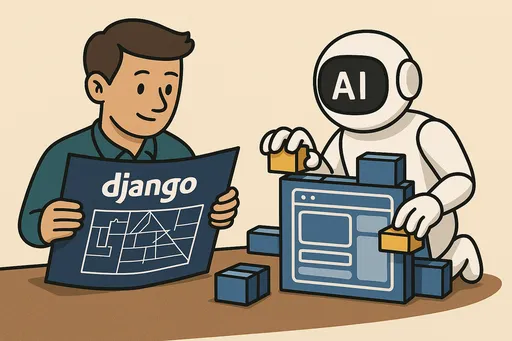In the Age of AI, the Frontend Collaborates with AI while the Backend Becomes More Important – So, Django?
In 2025, Microsoft laid off 6,000 employees due to the financial burden of AI investments. Surprisingly, 40% of those laid off were software engineers. This means not only were management positions reduced, but also developers who write code were cut as well. As Mark Zuckerberg of Meta pointed out, we can no longer ignore the reality that "a significant portion of the code we produce is handled by AI."
Indeed, according to employment statistics in the United States, programming jobs have dropped to their lowest level since 1980, and job postings for developers on hiring platforms have decreased by over 35%. In this age where AI is writing code, coders are increasingly becoming targets for restructuring.
In light of this change, what technology should we focus on? I believe this trend may lead to a resurgence of frameworks like Django.
In recent years, the separation of frontend and backend has become a fundamental structure in web development. The frontend is made up of React, Vue, and Svelte, while lightweight API servers like FastAPI or Firebase take care of the backend. Django is slowly being seen as an "old full-stack framework."
I think the background to this trend is that, from a business perspective, to rapidly launch web applications, the frontend and backend need to be clearly separated for parallel development. Frontend developers are usually not familiar with backend system structures or data modeling, and conversely, backend developers tend to feel burdened when delving deep into CSS, JS, and especially the React ecosystem. In reality, many backend developers often find frontend work to be 'bothersome and tedious.'
In this reality, companies have adopted a completely split structure for frontend and backend to maximize productivity and development speed. This means there is a perception that it is efficient to develop simultaneously around APIs and to focus on each other's areas of expertise. Perhaps this structure was a semi-coerced decision for team management and practical productivity rather than a natural flow.
However, nowadays, I find myself imagining a completely different future. With the rapid advancement of AI, the frontend is likely to be quickly automated by AI, and I strongly sense that the landscape in development might shift back towards Django.

Frontend: The Area Where AI Can Penetrate First
UI composition, page layout, responsive styling, component assembly, animation effects... These tasks are often repetitive and rule-based. Tools based on GPT can now transform Figma designs into code and even suggest basic components and styles when you say, "Make a dashboard page like this."
In other words, the frontend has already shifted from being a helper to a significant creator for AI. Although it may not be fully automated, productivity improvements will be tremendous.
In this situation, companies will question:
"Do we really need to hire frontend personnel or run a React-specific server?"
Backend: Business Logic Remains a Human Domain
While AI can quickly write code for the frontend, the backend is different. This is because the backend contains essential business logic that is core to the service, rather than just simple component assembly.
To put it simply, - The frontend focuses on "what is visible," where AI can quickly assemble code within predictable frameworks, - The backend is "invisible," yet it is where the essence of the service is held.
Here’s the critical point:
AI is good at writing rule-based code but does not understand the context and strategy of the service.
Therefore, the backend still requires high-level judgment and structural design. And such structural designers are not mere developers but rather service architects.
For these architect-type developers to cover the overall operations of small teams, the framework must be robust and integrated. This is where Django shines.
On the other hand, for the backend, tasks such as the following still require human judgment and experience:
- Data model design (normalization, relational structure)
- Authentication/authorization logic
- Integration with external systems (payments, notifications, third-party APIs)
- Performance tuning, transaction control
- Asynchronous processing, job queue design (e.g., Celery)
In other words, while AI can assist, it cannot replace in this field.
Django Will Naturally Attract Attention Again for Small Teams or Solo Developers
As the number of small-scale developments increases thanks to AI, teams will become more elite and lean. This will naturally lead to the following questions:
"Do I have to manage all this: React + FastAPI + Celery + Redis + Docker?"
This is where Django comes into play.
- ORM: Built-in
- Authentication system: Included by default
- Admin page: Automatically generated
- Just add DRF for APIs
- Many official guides for Celery integration
Whether there’s one person or three, Django can cover most backend tasks. If you can also use templates, it can even address some frontend needs.
Back to Django? The Cycle of Technology
FastAPI is excellent. I like it too. However, in an era where AI builds the frontend, an integrated Django might once again become the ideal choice.
- "Can it also do templates?" → Yes, it can.
- "Can it do APIs?" → Just add DRF.
- "Can it integrate with Celery?" → Yes, it works well.
In the future, many teams will ponder:
"If the frontend is automated, what should we simplify?"
The answer may be Django. That’s my prediction.
Of course, full-stack frameworks like Django can also be found in the PHP arena with Laravel, the Ruby field with Rails, and in JS with Next.js full-stack options. But there’s a crucial difference.
The key point is that the core of AI technology lies within the Python community. Most generative AIs, data science, and machine learning frameworks are Python-based, and it is highly likely that future web services will be seamlessly integrated with AI functionalities.
This means that in the age of AI, web frameworks are likely to center around the Python community, and in that context, Django is a choice that aligns best with the technological trend.
Conclusion
Technology continues to evolve, and AI is accelerating that pace. However, amidst these changes, frameworks that maintain stability and productivity still hold value.
And I see a high possibility that Django will once again take that central spot.
Furthermore, I believe that to survive, developers must grow from being mere 'coders' who type code, into architects who understand and can design systems and services as a whole. This way, rather than allowing AI to replace us, we can position ourselves to utilize AI to our advantage.
And I am convinced that one of the best frameworks to embark on that journey together is Django.
I will continue to use Django, and I believe even more people will return to it in the future.

There are no comments.